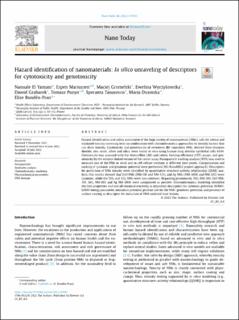Hazard identification of nanomaterials: In silico unraveling of descriptors for cytotoxicity and genotoxicity
El Yamani, Naouale; Mariussen, Espen; Gromelski, Maciej; Wyrzykowska, Ewelina; Grabarek, Dawid; Puzyn, Tomasz; Tanasescu, Speranta; Dusinska, Maria; Rundén-Pran, Elise
Peer reviewed, Journal article
Published version
Permanent lenke
https://hdl.handle.net/11250/3022015Utgivelsesdato
2022Metadata
Vis full innførselSamlinger
- Publikasjoner fra Cristin - NILU [1360]
- Vitenskapelige publikasjoner [1096]
Sammendrag
Hazard identification and safety assessment of the huge variety of nanomaterials (NMs), calls for robust and validated toxicity screening tests in combination with cheminformatics approaches to identify factors that can drive toxicity. Cytotoxicity and genotoxicity of seventeen JRC repository NMs, derived from titanium dioxide, zinc oxide, silver and silica, were tested in vitro using human lung alveolar epithelial cells A549. Cytotoxicity was assessed with the AlamarBlue (AB) and colony forming efficiency (CFE) assays, and genotoxicity by the enzyme-linked version of the comet assay. Nanoparticle tracking analysis (NTA) was used to measure size of the NMs in stock and in cell culture medium at different time points. Categorization and ranking of cytotoxic and genotoxic potential were performed (EU-NanoREG2 project approach). Descriptors for prediction of NMs toxicity were identified by quantitative structure-activity relationship (QSAR) analysis. Our results showed that ZnO NMs (NM-110 and NM-111), and Ag NMs (NM-300K and NM-302) were cytotoxic, while the TiO2 and SiO2 NMs were non-cytotoxic. Regarding genotoxicity, TiO2 NM-100, ZnO NM-110, SiO2 NM-203 and Ag NM-300K were categorized as positive. Cheminformatics modeling identified electron properties and overall chemical reactivity as important descriptors for cytotoxic potential, HOMO-LUMO energy parameter, ionization potential, pristine size for the NMs´ genotoxic potential, and presence of surface coating as descriptor for induction of DNA oxidized base lesions.

